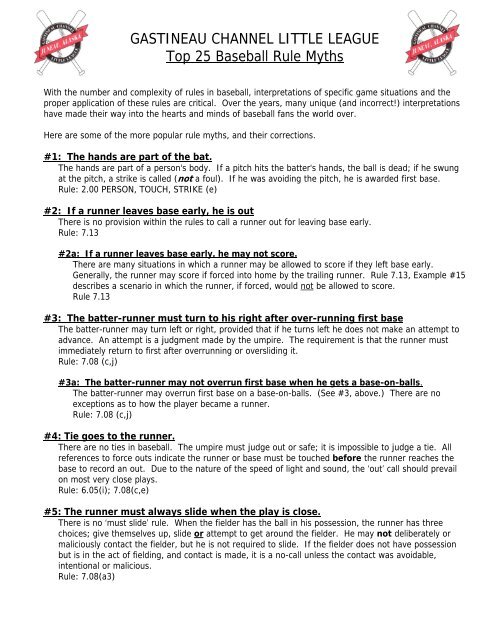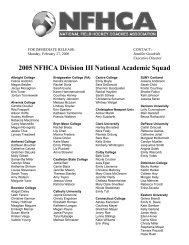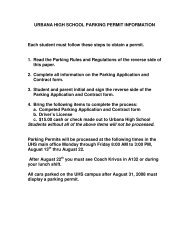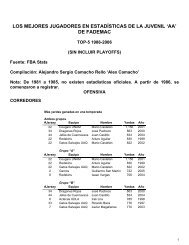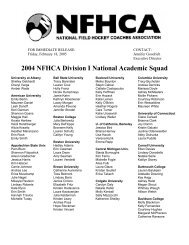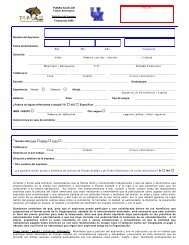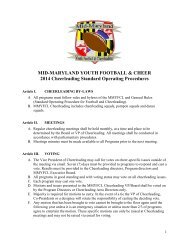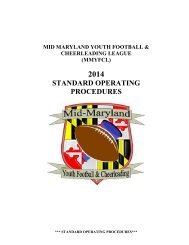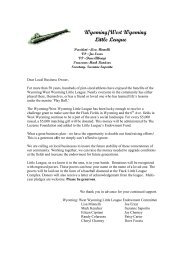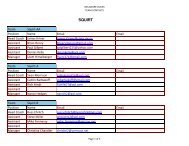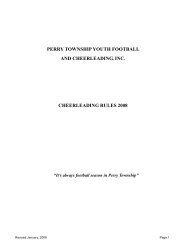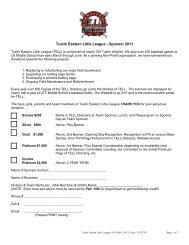GASTINEAU CHANNEL LITTLE LEAGUE Top 25 Baseball ... - Eteamz
GASTINEAU CHANNEL LITTLE LEAGUE Top 25 Baseball ... - Eteamz
GASTINEAU CHANNEL LITTLE LEAGUE Top 25 Baseball ... - Eteamz
Create successful ePaper yourself
Turn your PDF publications into a flip-book with our unique Google optimized e-Paper software.
<strong>GASTINEAU</strong> <strong>CHANNEL</strong> <strong>LITTLE</strong> <strong>LEAGUE</strong><strong>Top</strong> <strong>25</strong> <strong>Baseball</strong> Rule MythsWith the number and complexity of rules in baseball, interpretations of specific game situations and theproper application of these rules are critical. Over the years, many unique (and incorrect!) interpretationshave made their way into the hearts and minds of baseball fans the world over.Here are some of the more popular rule myths, and their corrections.#1: The hands are part of the bat.The hands are part of a person's body. If a pitch hits the batter's hands, the ball is dead; if he swungat the pitch, a strike is called (not a foul). If he was avoiding the pitch, he is awarded first base.Rule: 2.00 PERSON, TOUCH, STRIKE (e)#2: If a runner leaves base early, he is outThere is no provision within the rules to call a runner out for leaving base early.Rule: 7.13#2a: If a runner leaves base early, he may not score.There are many situations in which a runner may be allowed to score if they left base early.Generally, the runner may score if forced into home by the trailing runner. Rule 7.13, Example #15describes a scenario in which the runner, if forced, would not be allowed to score.Rule 7.13#3: The batter-runner must turn to his right after over-running first baseThe batter-runner may turn left or right, provided that if he turns left he does not make an attempt toadvance. An attempt is a judgment made by the umpire. The requirement is that the runner mustimmediately return to first after overrunning or oversliding it.Rule: 7.08 (c,j)#3a: The batter-runner may not overrun first base when he gets a base-on-balls.The batter-runner may overrun first base on a base-on-balls. (See #3, above.) There are noexceptions as to how the player became a runner.Rule: 7.08 (c,j)#4: Tie goes to the runner.There are no ties in baseball. The umpire must judge out or safe; it is impossible to judge a tie. Allreferences to force outs indicate the runner or base must be touched before the runner reaches thebase to record an out. Due to the nature of the speed of light and sound, the ‘out’ call should prevailon most very close plays.Rule: 6.05(i); 7.08(c,e)#5: The runner must always slide when the play is close.There is no ‘must slide’ rule. When the fielder has the ball in his possession, the runner has threechoices; give themselves up, slide or attempt to get around the fielder. He may not deliberately ormaliciously contact the fielder, but he is not required to slide. If the fielder does not have possessionbut is in the act of fielding, and contact is made, it is a no-call unless the contact was avoidable,intentional or malicious.Rule: 7.08(a3)
#6: The batter is out if his foot touches the plate.To be out, the batter's foot must be entirely outside the box when he contacts the pitch and the ballgoes fair or foul. He is not out if he does not contact the pitch. There is no statement in the rulesabout touching the plate. The toe could be on the plate and the heel could be touching the line of thebox, which means the foot is not entirely outside the box.Rule: 6.06(a)#7: A pitch that bounces to the plate cannot be hit.A pitch is a ball delivered to the batter by the pitcher. It doesn't matter how it gets to the batter. Thebatter may hit any pitch that is thrown. A pitch that bounces before reaching the plate, and is notswung at by the batter may never be a called strike.Rule: 2.00 PITCH (Note: If the ball does not cross the foul line, it is not a pitch.)#7a: The batter does not get first base if hit by a pitch after it bounces.See #7, above. If the batter is hit by a pitch while attempting to avoid it, he is awarded first base.Rules: 2.00 PITCH, 6.08(b)#8: Runners may not advance when an infield fly is called.An Infield-fly is no different than any other fly ball in regard to the runners’ ability to advance. Theonly difference is that they are never forced to advance because the batter is out whether the ball iscaught or not.Rules: 2.00 INFIELD-FLY, 6.05(d), 7.08(f, Note 1)#9: If a player's feet are in fair territory when the ball is touched, it is a fair ball.The position of the player's feet or any other part of the body is irrelevant. A ball is judged fair or foulbased on the relationship between the ball and the ground at the time the ball is touched by thefielder.Rule: 2.00 FAIR, FOUL#10: The home plate umpire can overrule the other umpires at anytime.The umpire who made the ruling may ask for help if he wishes. No umpire may overrule anotherumpire's call.Rules: 9.02(b,c)#11: A runner is out if he runs out of the baseline to avoid a fielder who is fielding abatted ball.The runner must avoid a fielder attempting to field a batted ball. A runner is out for running out of thebaseline, only when attempting to avoid a tag.Rules: 7.08(a1), 7.09(l)#11a: The batter-runner is always out if he runs outside the running lane after a buntedball.The runner must be out of the lane and cause interference. He is not out simply for being outsidethe lane. He could be called for interference even while in the lane. This is a judgment call. Therunner may step out of the lane a step or two before the base if he moves from within the lane toout of it. If he is out of the lane the whole distance to the base and is hit with a throw, he shouldbe out.Rules: 2.00 INTERFERENCE, 6.05(j), 7.09(k)#12: You must tag the base with your foot on a force out or appeal.You can tag a base with any part of the body.Rules: 2.00 FORCE PLAY, PERSON, TAG, 7.08(e)
#13: If a batted ball hits the plate first it's a foul ball.The plate is in fair territory. If a batted ball hits it, it is treated like any other batted ball.Rule: 2.00 FAIR TERRITORY#14: The batter cannot be called out for interference if he is in the batter's box.Many people believe the batter's box is a safety zone for the batter. It is not. The batter is protectedwhile in the box for a short period of time. After he has had time to react to the play, a batter could becalled out for interference if the umpire judges that interference could, or should, have been avoided.The batter may be called out for interference although he is within the box. The key words ‘impede’,‘hinder’, ‘confuse’ and ‘obstruct’ apply to this situation.An umpire must use good judgment. The batter cannot be expected to disappear. If he has a chanceto avoid interference after he has had time to react to the situation and does not, he is guilty. If hejust swung at a pitch, or had to duck a pitch and is off-balance, he can't reasonably be expected tothen immediately avoid a play at the plate. However, after some time passes, if a play develops at theplate, the batter must get out of the way and avoid interference.Rules: 2.00 INTERFERENCE(a); 6.06(c)#15: The ball is dead on a foul-tip.There is nothing foul about a foul-tip. If the ball nicks the bat and goes sharp and direct to thecatcher's hand or glove and is caught, then it is a foul-tip by definition. A foul-tip is a strike and theplay is live. It is the same as a swing-and-miss. If the ball is not caught, it is a foul ball. If the nickedpitch first hits the catcher somewhere other than the hand or glove, it is not a foul-tip, it is a foul ball.Rules: 2.00 FOUL-TIP, STRIKE(g)#15a: A runner may not steal on a foul-tip.See #15, above.Rules: 2.00 FOUL-TIP, STRIKE(g)#16: The batter may not switch batter's boxes after two strikes.The batter can switch boxes at any time, provided he does not do it after the pitcher is ready to pitch.Rules: 6.02(b); 6.06(b)NOTE: Little League recommends the umpire prevent this if it’s obviously being done to delay thegame.#17: The batter who batted out of order is the person declared out.The proper batter is the one called out. Any hit or advance made by the batter or runners due to thehit, walk, error or other reason is nullified. The next batter is the one who follows the proper batterwho was called out.Rule: 6.07(b,1)#18: If the batter does not pull the bat out of the strike zone when bunting, it's anautomatic strike.A strike is an attempt to hit the ball. Simply holding the bat over the plate is not an attempt. This isumpire judgment. In Rule 2.00, a BUNT is defined as ‘a batted ball not swung at, but intentionally metwith the bat…’; the key words here are ‘intentionally met.’ If no attempt is made to make contact witha ball outside the strike zone, it should be called a ball. An effort must be made to intentionally meetthe ball with the bat.Rule 2.00 BUNT & STRIKE
#19: The batter is out if a bunted ball hits the ground, bounces back up & hits his heldbat.The rule says the bat cannot hit the ball a second time. When the ball hits the bat, it is not an out.Also, when the batter is still in the box when this happens, it's treated as simply a foul ball. Only if thebatter is out of the box and the bat is over fair territory when the second hit occurs, could the batterbe called out.Rules: 6.05(h) & 7.09(b)#20: The runner gets the base he's going to, plus one on a ball thrown out-of-play.There is no such thing as a ‘one-plus-one’ base award. When a fielder other than the pitcher throwsthe ball into dead ball area, the award is always 2 bases. The award is from where the runners wereat the time of the pitch if it is the first play by an infielder before all runners have advanced or fromwhere each runner was physically positioned at the time the ball left the throwers hand on all otherplays.Rule: 7.05(g)#21: The runner is always safe when hit by a batted ball while touching a base.The bases are in fair territory. A runner is out when hit by a fair batted ball while touching a base,except when hit by an infield-fly or after the ball has passed a fielder and no other fielder had a play onthe ball. If the runner is touching first or third, he is not out unless the ball touches him over fairterritory. If one foot is on the base and the other is in foul ground and he is hit on the foul groundfoot, he is not out. It is a foul ball. (If the ball has not passed beyond first or third.)Rules: 5.09(f), 7.08(f)#22: It is a force out when a runner is called out for not tagging up on a fly ball.A force play is when a runner is forced to advance because the batter became a runner. When thebatter is out on a caught fly, all forces are removed. An out on a failure to tag-up is not a force out.Any runs that cross the plate before this out will count.Rules: 2.00 FORCE PLAY, 4.09(a)#23: An appeal on a runner who missed a base cannot be a force out.A runner must touch all the bases. If the runner misses a base to which he was forced because thebatter became a runner, and is put out before touching that base, the out is still a force play. If this isthe third out, no runs may score. The base or the runner can be touched; either way, it's a force out.Rules: 2.00 FORCE PLAY, TAG, 7.08(e), 7.10(b)#24: The ball must always be returned to the pitcher before an appeal can be made.An appeal may be made anytime the ball is alive. The only time the ball must go to the pitcher, iswhen time is out. The ball cannot be made live until the pitcher has the ball while on the rubber andthe umpire says ‘Play.’ If time is not out, the appeal can be made immediately.Rule: 2.00 APPEAL, 5.11, 7.10#<strong>25</strong>: The ball is dead anytime an umpire is hit by the ball.If an umpire is hit by a batted ball before it passes a fielder, the ball is dead. On any other batted orthrown ball, the ball is alive when the umpire is hit with the ball.Rules: 2.00 INTERFERENCE, 5.09(b, f)


